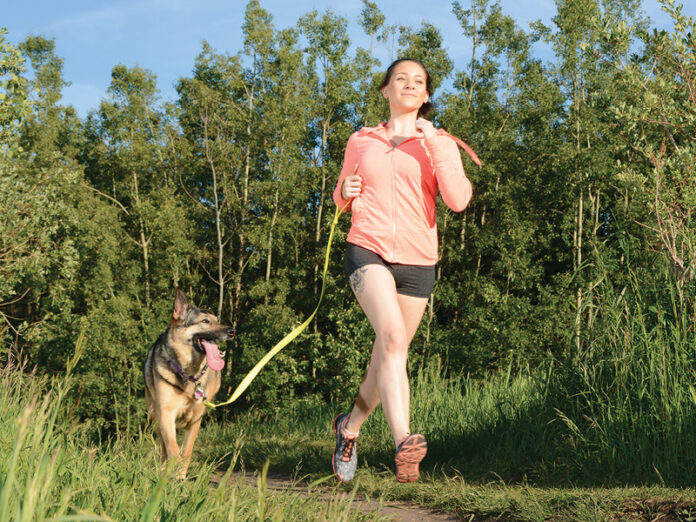
Most dogs love to run, but running with your dog can pose a new challenge, particularly for the dog. IMPACT asked Dr. Seanna Swayne, a Toronto veterinarian and Elizabeth Macey, co-owner of Dog Gone Running service in Calgary, for advice on what you need to know before running with your dog. Talk to your veterinarian first to ensure your dog is fit to run, then, if all is good, head out for some canine cardio.
Do I have the right breed for running?
A larger breed is probably not going to have too much trouble running, but their pace may be slower. It’s important to start slow and run at their pace. Many smaller breeds absolutely love to run and are well adapted to the activity. Dogs that have joint or hip issues can have their conditions exacerbated by running and strenuous activity is not advised. Always keep an eye out for signs of fatigue such as panting, lagging behind, wanting to stop or distracted behaviour.
Are there any breeds that shouldn’t run?
Use caution running dogs with short, flat noses, so-called brachycephalic dogs, particularly in hot weather. Dogs pant to cool off and brachycephalic dogs don’t pant as efficiently as other breeds. Some common flat-nosed dog breeds are Pug, English Bulldog, French Bulldog, Cavalier King Charles Spaniel, Boston Terrier, Shih Tzu and Pekinese.
What are the benefits of running my dog?
Exercise is a must for every dog, whether that’s walking or running. Running will help your pooch keep her weight in check, develop a stronger heart and lungs and increase bone density. A well-exercised dog will also sleep better, be less prone to rip up the house when you are not there, and will love you to death for all the attention he’s getting. Start slowly and allow your dog to build fitness.
Doggie dos and don’ts:
- Focus on your dog when you run.
- Tune in to your dog’s behaviour, body language and cues when you are running with him. You will recognize when he is tired, stressed or injured.
- Do not wear headphones and cycling while your dog runs is rarely a good idea, on or off leash.
- Focus on the path to ensure that it’s safe for both you and others.
Do I need special gear?
A hands-free leash is excellent for runner safety and can prevent shoulder injuries if the dog makes a sudden lunge. Bring water for your dog (and you) on hot days and consider a coat and booties in the winter.
What sort of pace can I run with my dog?
Pace depends on the dog and his cardiovascular condition. Start with a slow and steady pace and continuously monitor your dog for signs of fatigue. Some dogs prefer sprinting, so time at the off-leash park fetching a ball is also a great activity. Maybe that’s when you get your speedwork in, too!
How old should my dog be to run with me?
Your dog should be old enough to have their full set of vaccinations. If you have a large breed, wait until they’ve reached skeletal maturity (six to eight months for small breeds, about a year for medium dogs and 15-18 months for large breeds) before taking them out on extended runs.
Endurance Champions
Humans are one of the few species built for endurance, but most of our four-legged friends are more suited to sprinting. Here’s a list of quadrupeds (and the bipedal ostrich) and their estimated marathon times.
Ostrich
- Max Speed: 80 km/h
- Ave. Speed: 48 km/h Marathon Time: 0:45
Pronghorn Antelope
- Max Speed: 88.5 km/h
- Ave. Speed: 48 km/h
- Marathon Time: 0:45
Camel
- Max Speed: 64 km/h
- Ave. Speed: 40 km/h
- Marathon Time: 1:02
Dog* (Alaskan Husky sled dogs pulling as a team)
- Max Speed: 40 km/h
- Ave. Speed: 24 km/h
- Marathon Time: 1:19
Human
- Max Speed: 44.17 km/h
- Usain Bolt: 9.58 seconds – 100M World Record
- Ave. Speed: 20.4 km/h
- Halle Gebrselassie: 2:03:59 – Marathon World Record
Horse
- Max Speed: 54 km/h
- Ave. Speed: 10.5 km/h
- Marathon Time: 2:30
Chart source: popularmechanics.com













